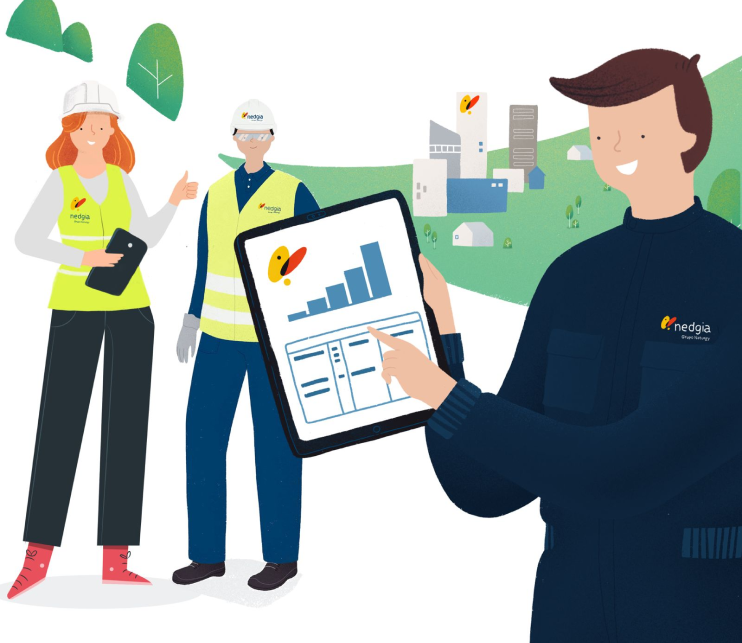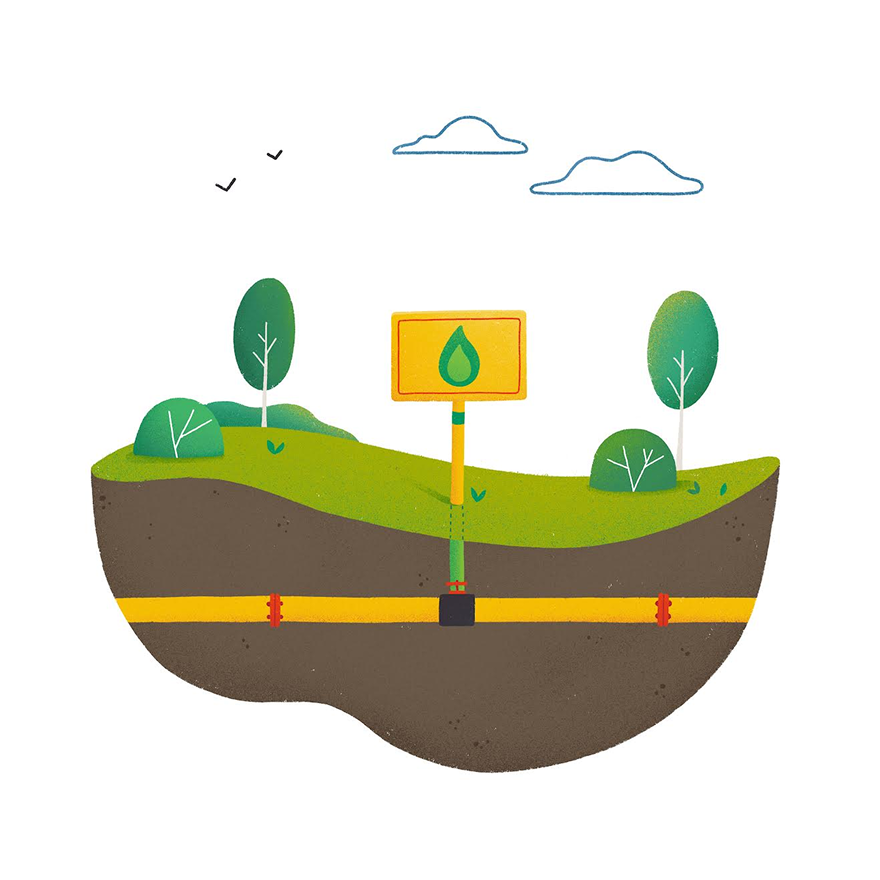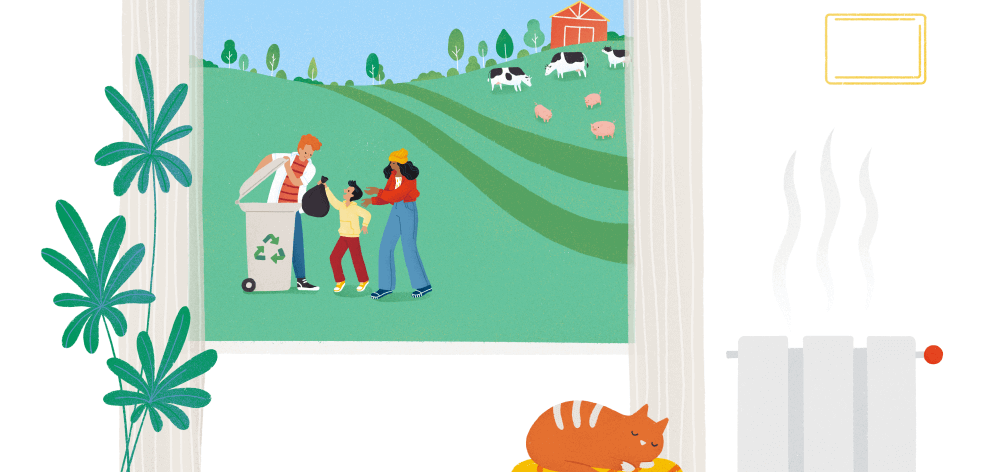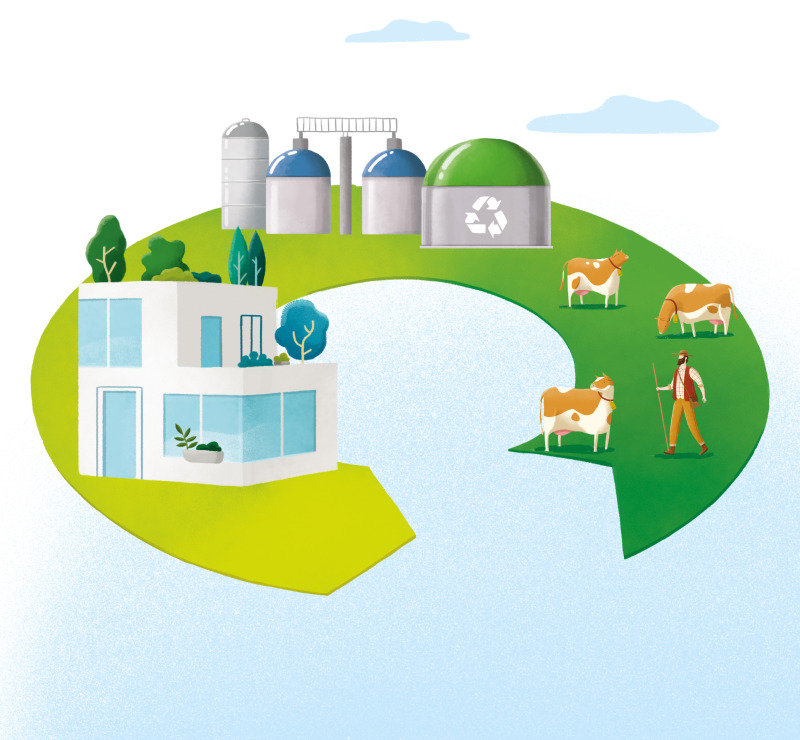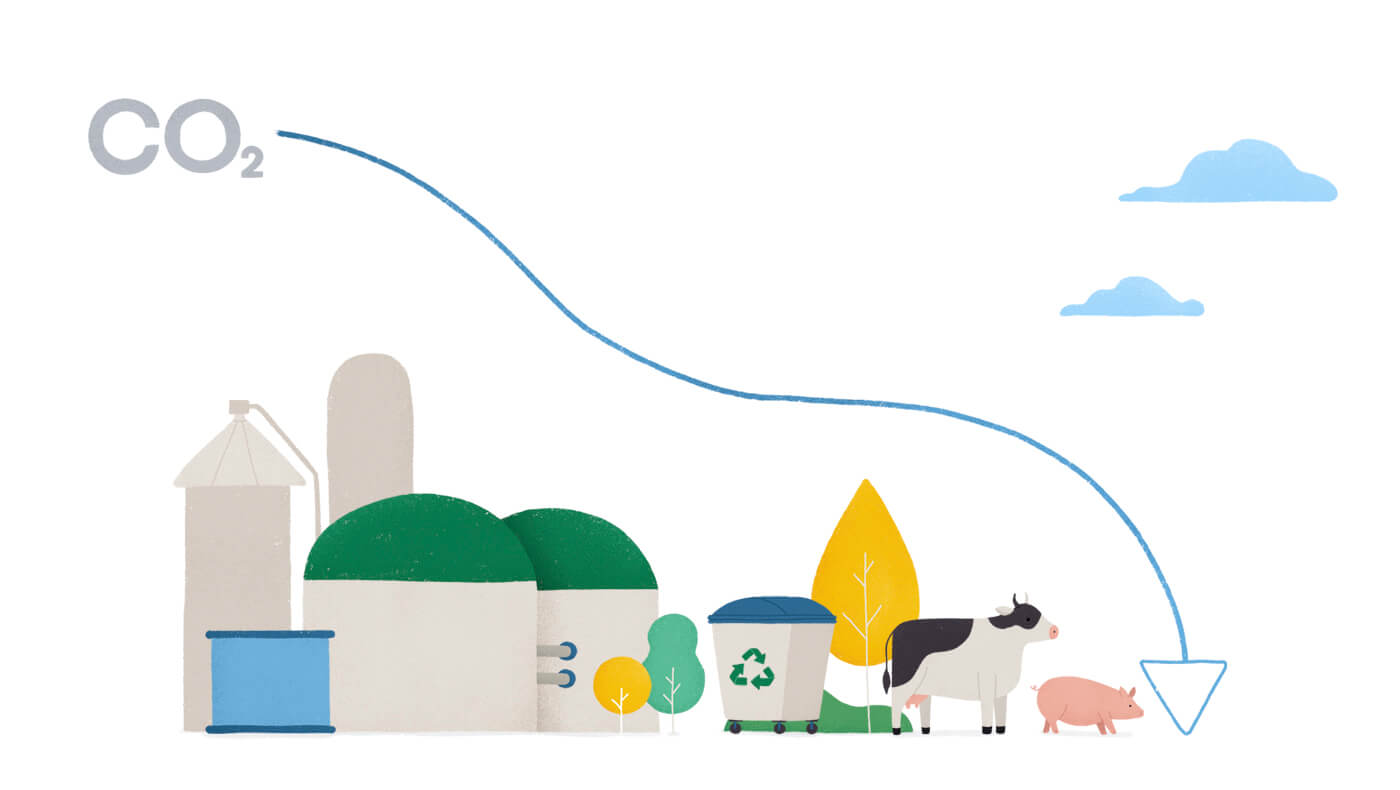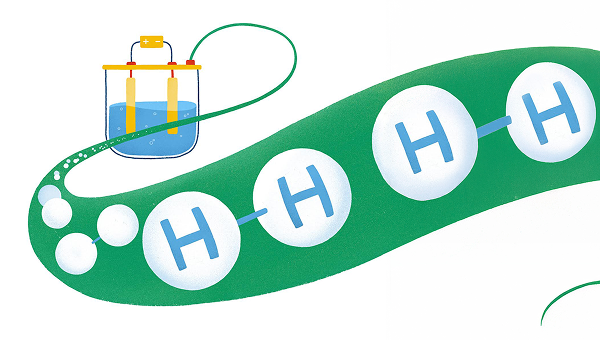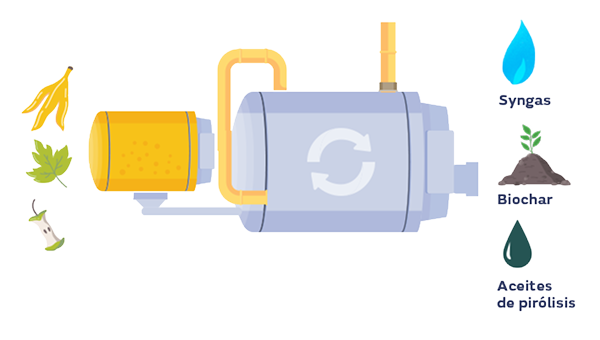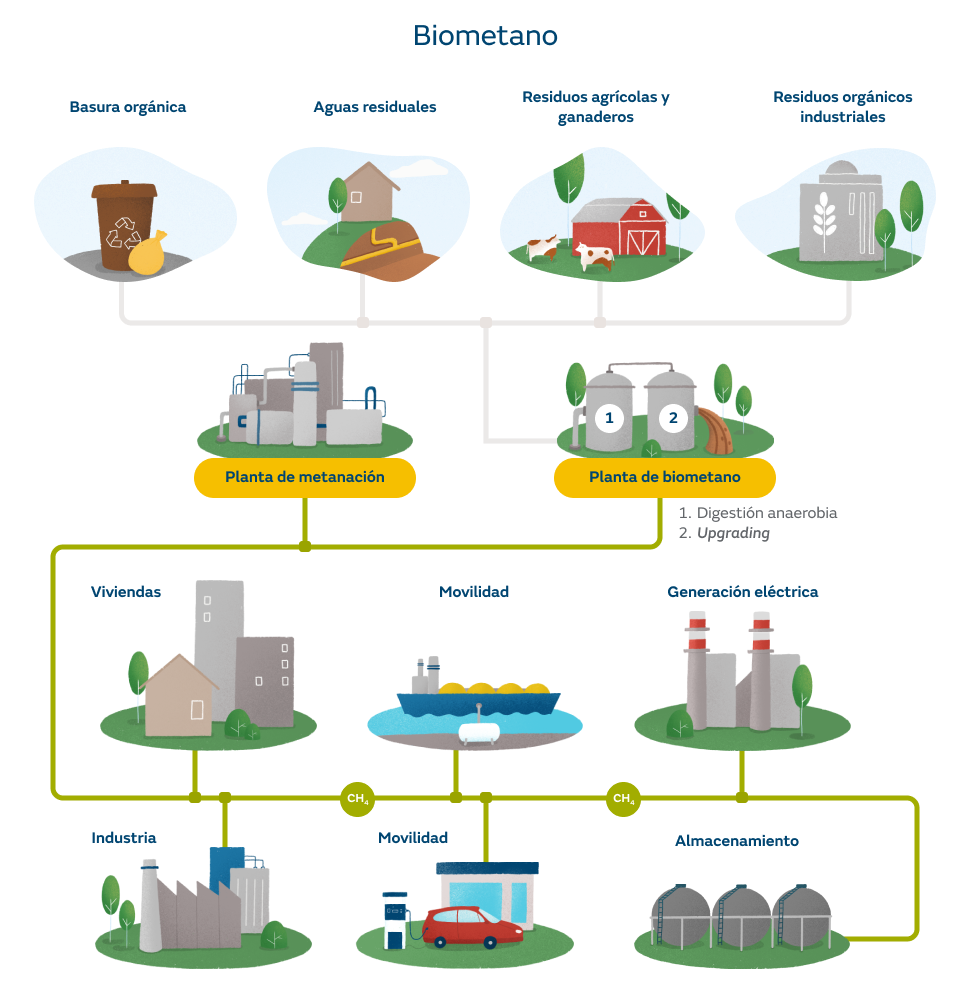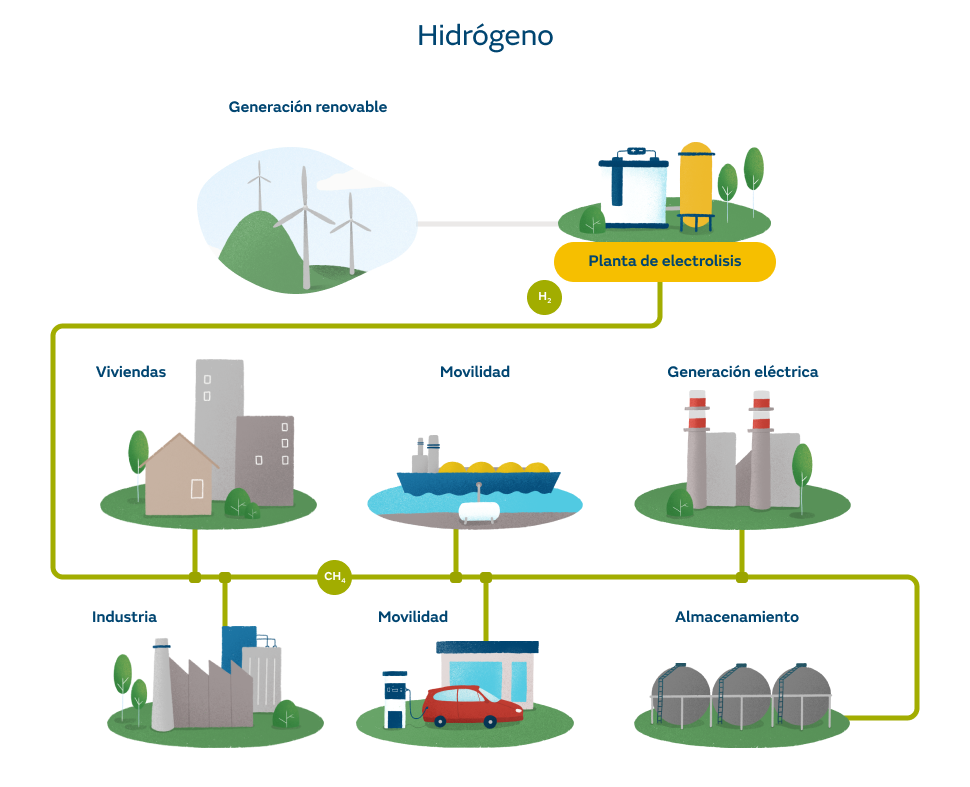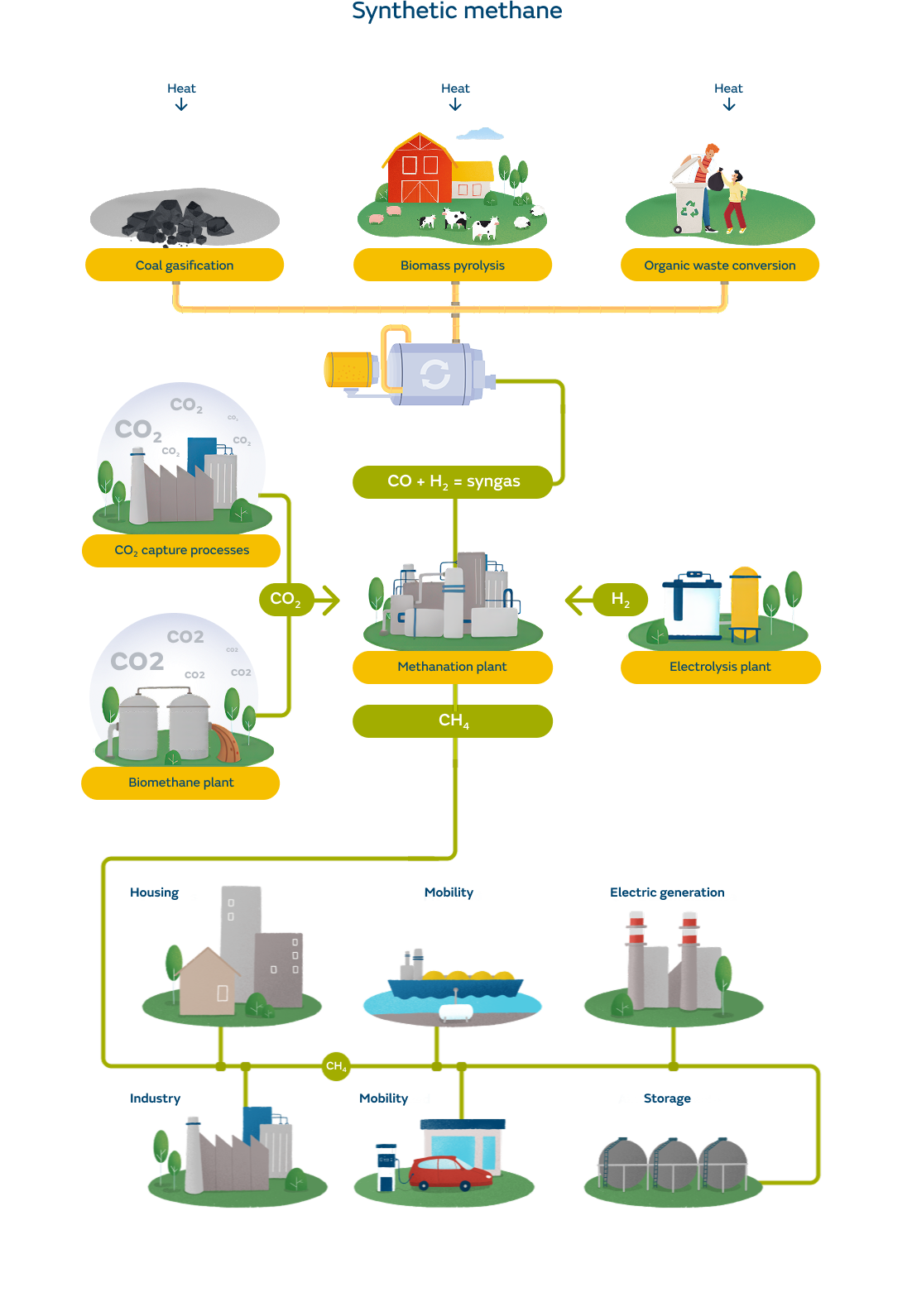What is green or renewable gas?
Discover the main characteristics of renewable gases
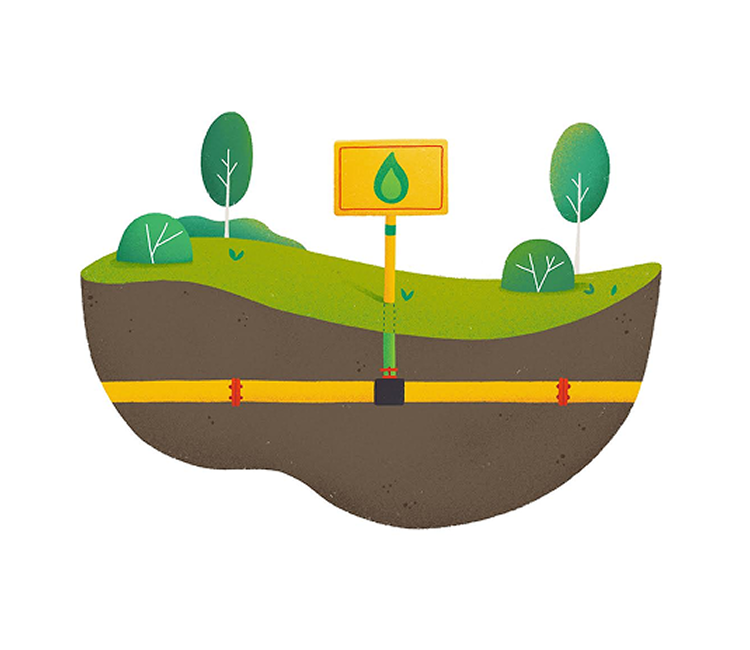
Green gas
Obtained from biogas, biomethane is a gas that has a similar composition to natural gas and can therefore be injected into the gas system with no restrictions.
Other green gases
Plants in operation
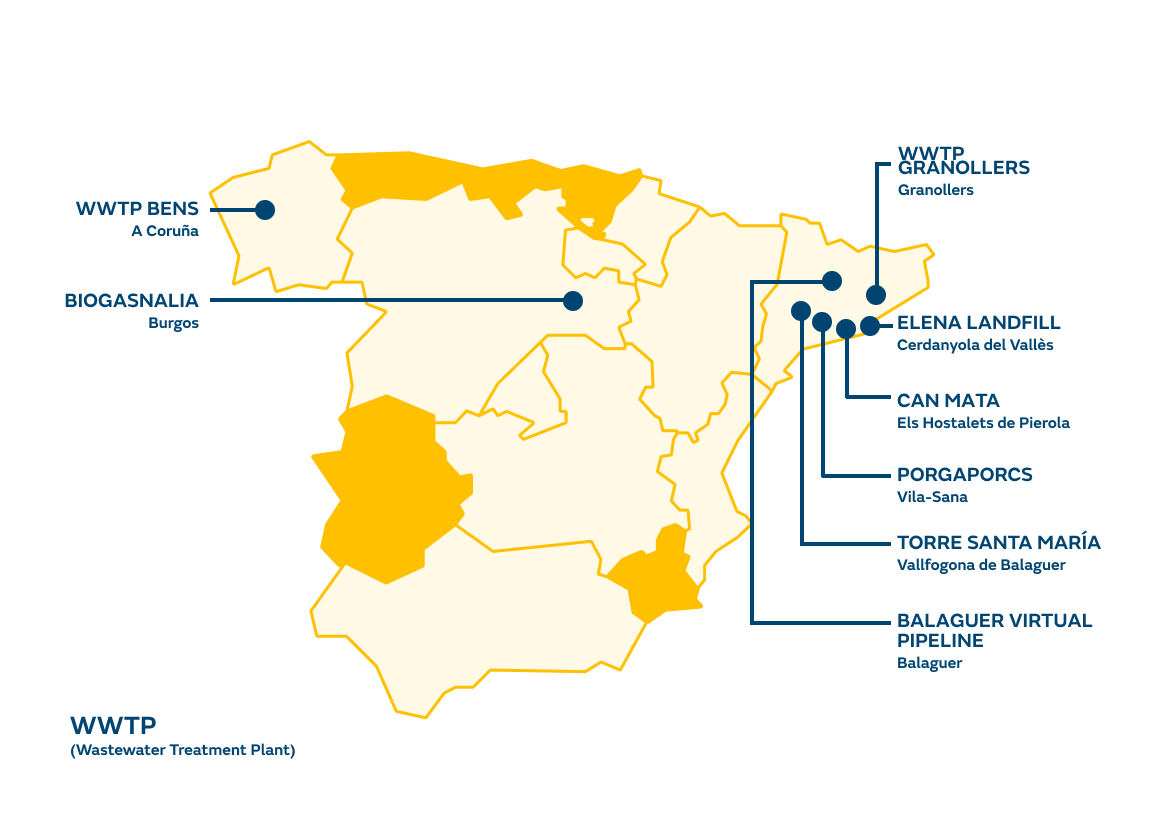
Elena Landfill – Cerdanyola del Vallés, Barcelona
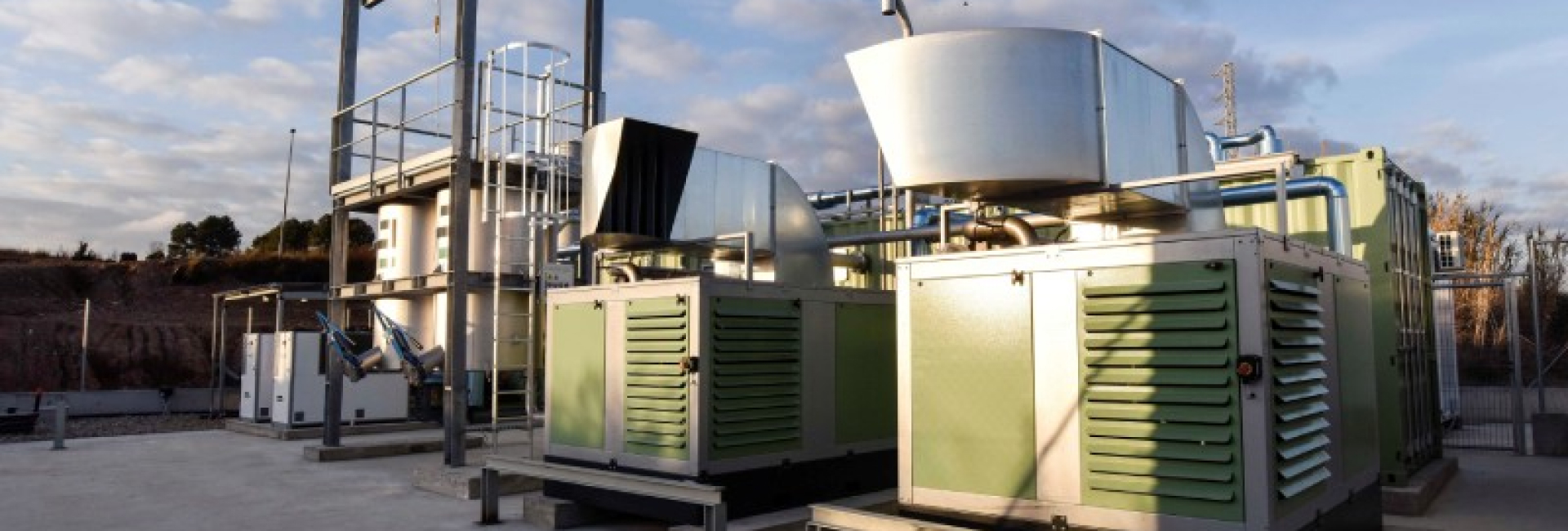
Promoter Naturgy
This renewable gas plant next to the Elena landfill in Parc de l’Alba represents a major milestone: it was the first to inject renewable gas from a landfill into the gas distribution network in Spain.
But that’s not all. It also represents a green energy project, will support the circular economy and is a clear reflection of our support for local energy production.
With this facility, we are demonstrating our capacity for success on this type of project based on the strength of our distribution network, which is ready to distribute renewable gases due to the investments made in recent years, the existing gas infrastructure in Spain and its contribution to supply security.
- 15 Gwh/year, enough to supply 2,942 homes.
- Reduction of CO2 emissions by 2,730 tonnes/year, equivalent to the planting of 295,135 trees.
- Biomethane from landfill waste.
Biogasnalia – Burgos
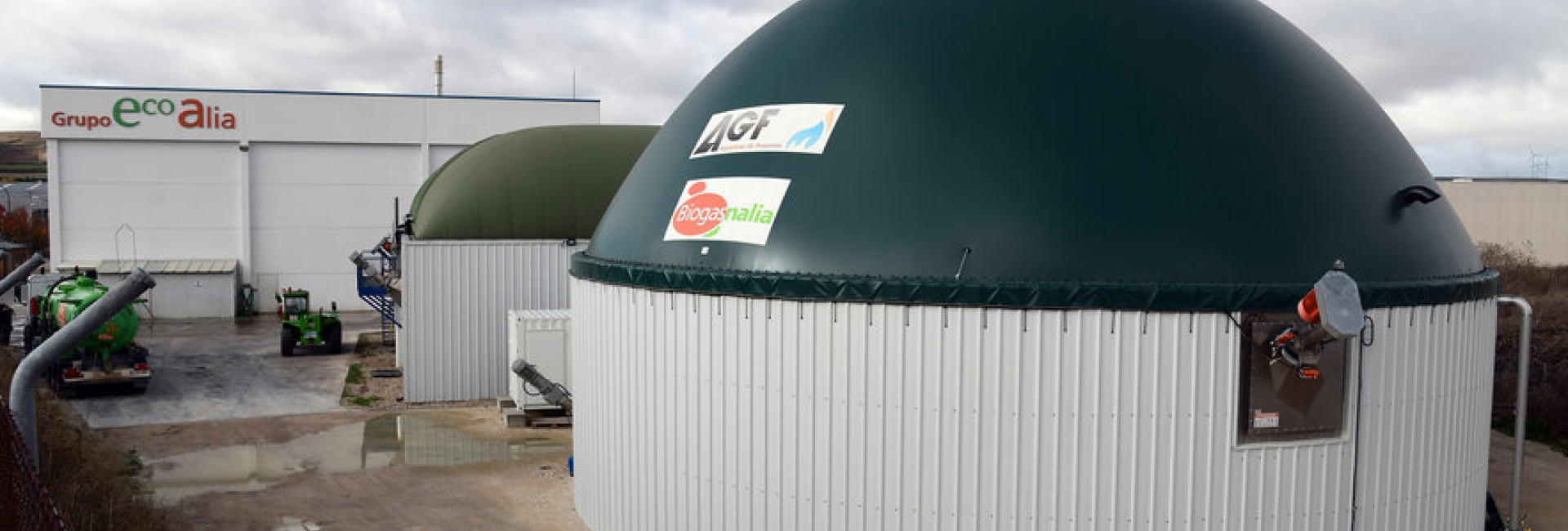
Promoter BIOENGAS/ENAGAS
The UNUE project biogas plant, located on the Biogasnalia site, is the first plant in Spain to inject biomethane from agri-food waste. It receives up to 90 tonnes/day of waste from various food and agri-food industries.
Switching the biogas plant over to biomethane enables production continuity and fluidity, without stopping and without losses.
- 25 Gwh/year, the annual energy supply of 4,904 homes.
- Reduction of CO2 emissions by 4,550 tonnes/year, equivalent to the planting of 491,891 trees.
- Biomethane from industrial waste.
Torre de Santamaría – Vallfogona de Balaguer, Lleida
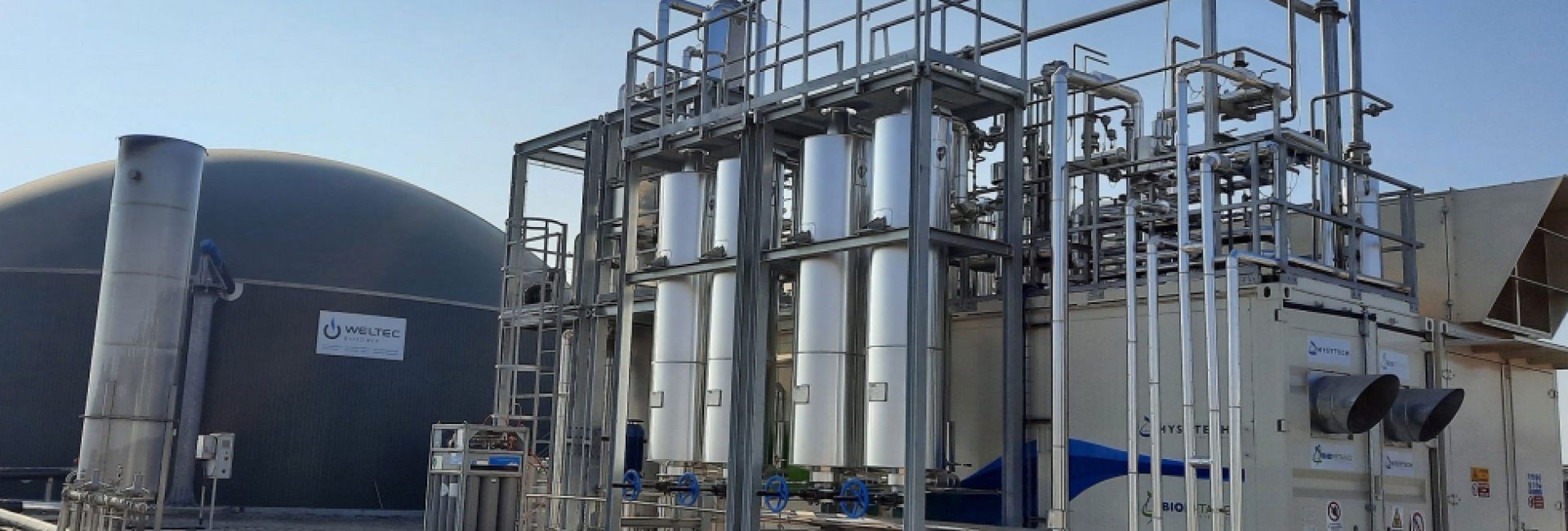
Promoter AXPO / HYSYTECH
This facility produces biogas from organic waste generated by cows, marking another milestone: it is the first to use organic waste generated by animals. This waste is enriched via a decomposition and enrichment process to convert it into renewable gas.
It is a fine example of supporting a sustainable economy, a circular economy and the use of an extremely abundant form of waste, the quantity of which can lead to problems elsewhere. Thanks to this plant, we ensure this resource becomes an opportunity.
- 30 GWh/year of biomethane, enough to supply 5,885 homes.
- Reduction of CO2/year by 5,460 tonnes, equivalent to the planting of 590,270 trees.
- Biomethane from organic livestock waste.
Bens WWTP – La Coruña

Promoter Naturgy
The state-owned company Edar Bens SA is responsible for treating the wastewater from council authorities in A Coruña and also represents a major milestone: in 2016, an initiative was launched to install the first Mixed Renewable Gas Unit. This unit increases the usage effectiveness of biomethane obtained from the treatment of urban wastewater. The goal is to achieve 100% useful power generation.
Given that the company was already using biomethane at its own installations, we partnered with them to inject their biomethane into the natural gas network and thereby harness this resource more efficiently.
- 5 GWh/year of biomethane, enough to supply 980 homes.
- It will avoid emissions of 910 tonnes of CO2/year, equivalent to the planting of 98,378 trees.
- Biomethane from the Waste Water Treatment Plant.
Can Mata – Els Hostalets de Pierola, Barcelona

Promoter WAGA / Prezero
This facility, which treats urban and industrial waste from Barcelona and its area of influence, has been operated for more than 30 years by PreZero Spain, treating more than 22 million tonnes of waste during this period.
The waste stored at Can Mata produces almost 40 million cubic metres of biogas per year, used up to now to produce thermal energy for drying concentrates from leachate treatment, as well as for producing electricity and thermal energy to manufacture construction materials.
Thanks to this new technology, the controlled waste repository will recover 100% of the biogas.
- It will produce 71 GWh/year of biomethane, equivalent to the annual consumption of 13,929 homes.
- It will avoid the emission of 12,922 tonnes of CO2/year into the atmosphere, equivalent to the planting of 1,396,972 trees.
- Biomethane from landfill waste.
Granollers WWTP – Granollers, Barcelona

Promoter Consorci Besos Tordera
By launching this project, Nedgia guarantees the injection of 28 GWh/year of biomethane into the grid, thus contributing to renewable gas penetration through its infrastructure.
The facility, driven by the Consorci per a la Gestió dels Residus del Vallès Oriental and the Consorci Besòs Tordera, produces biomethane from the management of 55,000 tonnes of organic waste and the treatment of 12 million m3 of wastewater per year.
- It will produce 28 GWh/year of biomethane, equivalent to the consumption of 5,493 homes.
- It will avoid the emission into the atmosphere of 5,096 tonnes of CO2/year, equivalent to the planting of 550,918 trees.
- Biomethane from the Waste Water Treatment Plant.
Porgaporcs – Vila-Sana, Lleida

Developer Naturgy
After an investment of 1.5 million euros, this facility will become the third plant commercially operated by the company in Spain and the second in Catalonia, and that inject renewable gas into the grid.
The Naturgy plant, located on the Porgaporcs livestock farm in Vila-Sana (Lleida), will generate biomethane to supply the equivalent annual consumption of 2,354 homes and will prevent the emission of 2,184 tonnes of CO2 per year into the atmosphere.
With this new plant, the company is taking a further step in its commitment to energy transition, local energy production and the circular economy, as it will supply clean gas to the energy system and contribute to the sustainable management of agricultural and livestock waste.
- It will produce 12 GWh/year of biomethane, equivalent to the consumption of 2,354 homes.
- It will avoid the emission of 2,184 tonnes of CO2/year into the atmosphere, equivalent to the planting of 236,108 trees.
- Biomethane from organic livestock waste.
Balaguer virtual gas pipeline – Balaguer, Lleida

Promotor FNX
Nedgia, gas distributor of the Naturgy group, and CycleØ have launched the first virtual gas pipe that will be capable of injecting renewable gas into the network from production points external to the infrastructure. This milestone is a major step forward for the development of biomethane, a carbon neutral gas obtained from waste treatment, in Spain, increasing the country's production potential and promoting the technical and economic viability of new developments.
The new virtual biogas pipeline will inject 40 GWh of renewable gas into the Nedgia network each year from different CycleØ production plants located in the province of Lleida. This amount is equivalent to the consumption of 7,847 households.
- It will produce 40 GWh/year of biomethane, equivalent to the consumption of 7,847 homes.
- It will avoid the emission into the atmosphere of 7,280 tonnes of CO2/year, equivalent to the planting of 787,027 trees.
- Biomethane from organic livestock waste.
Coren Arrabaldo – Santa Cruz de Arrabaldo, Ourense

Promoter COREN
This facility will become, after an investment of 0.3 million euros, the ninth plant in Spain and the second in Galicia that the company connects to its distribution networks to inject renewable gas into the grid.
The COREN plant, located at the poultry processing center of Santa Cruz de Arrabaldo (Ourense), will generate biomethane to supply the equivalent annual consumption of 3,000 homes and will prevent the emission of approximately 2,184 tons of CO₂ per year.
With this new plant, another step is taken in its commitment to the energy transition, local energy production, and the circular economy, as it will contribute clean gas to the energy system and support the sustainable management of agricultural and livestock waste.
- It will produce 15 GWh/year of biomethane, equivalent to the consumption of 3,000 households.
- It will prevent the emission of 2,184 tons of CO₂/year into the atmosphere.
- Biomethane sourced from organic waste from the poultry processing center.
Almazán – Soria

Promoter Redexis Renovables
The renewable gas plant in Almazán, Soria, represents a significant step forward in the energy transition and in promoting the circular economy in rural areas.
Promoted by Redexis Renovables, the facility has been renovated and modernized with an investment of more than €13 million, and is already injecting biomethane into the distribution network. With an annual production capacity of 20 GWh, enough to supply 3,170 households, it will use agricultural and livestock waste to generate local biomethane and integrate it into the local gas grid.
- 20 GWh/year, enough to supply 3,170 households.
- Biomethane from agricultural and livestock waste.
- Investment of more than €13 million in plant modernization.
Biomethane Montes de Toledo – Noez, Toledo

Promoter Biomethane Initiatives
The renewable gas plant Biomethane Montes de Toledo, located in Noez (Toledo), marks another step in the development of renewable gases in Spain. Promoted by Biomethane Initiatives, a joint venture formed by Suma Capital and Sitra, it has an annual production capacity of 40 GWh, enough to supply more than 6,500 households.
This facility will process up to 100,000 tons of waste each year (50,000 tons of cattle manure, 30,000 tons of pig slurry, and 20,000 tons of sewage sludge and agri-food waste) to generate local biomethane.
In addition, it will produce 30,000 tons of solid fertilizers, helping avoid the emission of 7,280 tons of CO₂.
- 40 GWh/year of biomethane, enough to supply 6,500 households.
- Production of 30,000 tons of solid fertilizers, reducing 7,280 tCO₂/year.
- Local biomethane from agricultural and agri-food waste.
E-Cogeneration Cabanillas – Navarra

Promoter E-Cogeneration Cabanillas
The renewable gas plant in Cabanillas, Navarra, is the first biomethane facility connected in this Autonomous Community. Promoted by E-Cogeneration Cabanillas, it has an annual production capacity of 22 GWh, enough to supply 4,000 households.
The expansion of the existing biogas plant makes it possible to inject local biomethane into the Nedgia network, by valorizing agricultural and livestock waste, mainly pig slurry, along with waste from the local food industry.
In addition to biomethane, the facility uses the generated digestate to produce organic fertilizers, thereby reducing the use of fossil-based fertilizers and strengthening the circular economy in rural areas.
- 22 GWh/year, enough to supply 4,000 households.
- Biomethane from pig slurry and agri-food industry waste.
- Valorization of digestate to reduce fossil fertilizer use.
Venta de Baños – Palencia

Promoter Tuero Medioambiente
The renewable gas plant in Venta de Baños, Palencia, is the first biomethane facility connected in this province and the third in Castilla y León. Promoted by Tuero Medioambiente, it has an annual production capacity of 43 GWh, enough to supply 8,600 households.
The facility produces local biomethane from agri-food waste, contributing to the circular economy and reinforcing Castilla y León’s role as a strategic region in the development of this energy.
- 43 GWh/year, enough to supply 8,600 households.
- Biomethane from agri-food waste.
- Third plant connected in Castilla y León and thirteenth in Spain to be connected to the Nedgia network.

Do you have any questions?
You may also be interested in
More about Nedgia

